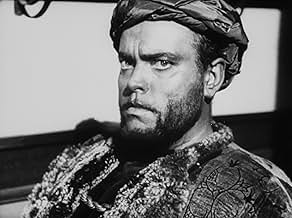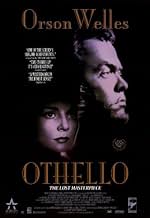IMDb RATING
7.5/10
9.7K
YOUR RATING
The Moorish General Othello is manipulated into thinking that his new wife Desdemona has been carrying on an affair with his Lieutenant Michael Cassio when in reality, it is all part of the ... Read allThe Moorish General Othello is manipulated into thinking that his new wife Desdemona has been carrying on an affair with his Lieutenant Michael Cassio when in reality, it is all part of the scheme of a bitter Ensign named Iago.The Moorish General Othello is manipulated into thinking that his new wife Desdemona has been carrying on an affair with his Lieutenant Michael Cassio when in reality, it is all part of the scheme of a bitter Ensign named Iago.
- Awards
- 1 win & 1 nomination
Abdullah Ben Mohamet
- Pageboy
- (uncredited)
Joseph Cotten
- Senator
- (uncredited)
Jean Davis
- Montano
- (uncredited)
Joan Fontaine
- Page
- (uncredited)
Robert Rietty
- Lodovico
- (voice)
- (uncredited)
Gudrun Ure
- Desdemona
- (voice)
- (uncredited)
- Director
- Writers
- All cast & crew
- Production, box office & more at IMDbPro
Storyline
Did you know
- TriviaThe movie was shot over three years and production was stopped twice, mainly because Welles ran out of money. He then starred in the films "The Third Man (1949)" and "Prince of Foxes (1949)." He took his payment from those films and used them as money for "Othello".
- Alternate versionsThis film by Orson Welles, was 'restored' by a group in Chicago in 1991/2. The film was transferred to, and enhanced in video, (D1 format) retaining it as black and white. The audio was completely rebuilt, including the score, in Stereo Surround. All dialogue, however was original. This was a problem as some of the dialogue was distorted and unintelligible. John Fogelson, editor, was a major supervisor of the project. Ed Golya, Lorita DeLacerna, and Steve Wilke, were digital editors. And Ed Golya remixed the soundtrack. The process took 9 months. It was purchased for distribution by Castle Hill, and taken to New York where it went through another transformation before release. The restoration engineer in New York, Paul Michael, restored the audio that was supplied on 35mm optical negatives. He was able to remove the distortion, optical pops and surface noise that is inherent with Optical negatives. The restored audio was then sent to Sound One for the final mix. Unintelligible dialogue was replaced with 'sound-alikes'. This decision was made for the entertainment value of the film. The original mono music was then reintroduced into the final product. Basically, the film was retransferred, and the rebuilt sound effects tracks were added. This was done at Sound One, in NYC.. The credits were adjusted to place Lee Dickter (sp?) as Re-recording Mixer, and Ed Golya as Sound Effects Editor.
- ConnectionsEdited into Histoire(s) du cinéma: La monnaie de l'absolu (1999)
Featured review
Considerable controversy has surrounded the 1992 restoration and re-release of Orson Welles' "Othello." First, the film was wrongly labelled a "lost classic" - not technically true, as Welles aficionados will realize. More seriously, the restoration crew (under the aegis of Welles' daughter, Beatrice Welles) re-synced the dialogue and re-recorded the musical score - an abomination to Welles purists. While it would have been preferable to adhere to Welles' vision for the film, such an endeavor becomes extremely difficult when no written record of Welles' intent exists (as it did with his famous 26-page memo to Universal regarding "Touch of Evil"). So it's true that the restored version lacks a degree of authenticity, but what are the alternatives? Grainy, scratched, poorly synced public domain prints (c.f. "Mr Arkadin" and "The Trial")? Or, worse, no available copy at all (c.f. "Chimes at Midnight")?
Anyway, on to the film. "Othello's" existence helps disprove the charges of profligacy and "fear of completion" that plagued Welles' career after "Citizen Kane." Shot over four years in Morocco and Italy, and financed largely by Welles himself, "Othello" manages to avoid a low-budget look, thanks largely to virtuoso editing that masks the incongruities of time and space. Welles' powers of invention are on full display here, most obviously in the famous Turkish bath scene (an improvised set necessitated by a lack of costumes). Set designer Alexandre Trauner's astute choice of Moroccan and Venetian locations instantly establishes a geographic authenticity; Welles initially exploits them for all their stark beauty before retreating into noirish interiors, underscoring Othello's descent into darkness.
Aside from Michael Macliammoir's chilling Method performance as Iago, the acting in Welles' "Othello" has been criticized as too restrained and modulated for Shakespearean tragedy. Such criticism is largely unwarranted, for this "Othello" is as much for the eyes as the ears: Welles' bold framing and expressionistic camera angles free the play from its theatrical moorings (pun intended), undermining the need for stage elocution. Indeed, the camera is the true star of this film, as Welles generates images that match the grandeur and eloquence of Shakespeare's language.
Anyway, on to the film. "Othello's" existence helps disprove the charges of profligacy and "fear of completion" that plagued Welles' career after "Citizen Kane." Shot over four years in Morocco and Italy, and financed largely by Welles himself, "Othello" manages to avoid a low-budget look, thanks largely to virtuoso editing that masks the incongruities of time and space. Welles' powers of invention are on full display here, most obviously in the famous Turkish bath scene (an improvised set necessitated by a lack of costumes). Set designer Alexandre Trauner's astute choice of Moroccan and Venetian locations instantly establishes a geographic authenticity; Welles initially exploits them for all their stark beauty before retreating into noirish interiors, underscoring Othello's descent into darkness.
Aside from Michael Macliammoir's chilling Method performance as Iago, the acting in Welles' "Othello" has been criticized as too restrained and modulated for Shakespearean tragedy. Such criticism is largely unwarranted, for this "Othello" is as much for the eyes as the ears: Welles' bold framing and expressionistic camera angles free the play from its theatrical moorings (pun intended), undermining the need for stage elocution. Indeed, the camera is the true star of this film, as Welles generates images that match the grandeur and eloquence of Shakespeare's language.
- How long is Othello?Powered by Alexa
Details
- Release date
- Countries of origin
- Official sites
- Languages
- Also known as
- Orson Welles' Othello
- Filming locations
- Castle, El Jadida, Morocco(cistern interior)
- Production companies
- See more company credits at IMDbPro
Box office
- Gross US & Canada
- $28,980
- Opening weekend US & Canada
- $6,010
- Apr 27, 2014
- Gross worldwide
- $28,980
- Runtime1 hour 30 minutes
- Color
- Aspect ratio
- 1.37 : 1
Contribute to this page
Suggest an edit or add missing content























